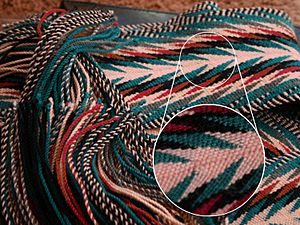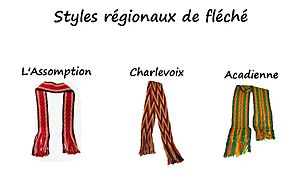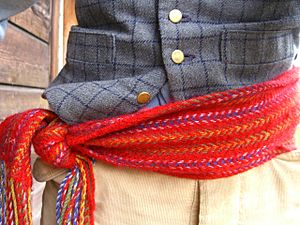Ceinture fléchée facts for kids
The ceinture fléchée (pronounced "san-toor flesh-ay") is a special, colourful sash. It's a traditional piece of clothing from Québec and is also very important to the Métis people. The name means "arrowed sash" in French, because of its unique arrow-like patterns.
This sash has been around since at least the 1600s. Both Québécois and Métis communities see the sash as a key part of their culture, history, and identity. It shows their pride and traditions. Some believe the idea for the sash came from traditional finger-woven sashes of Indigenous peoples, combined with European wool.
Contents
A Look Back: The Sash's Story
In Québec, men wore the ceinture fléchée in winter. They tied it around their winter coats to stay warm. It was practical but also very stylish! Both rich people and everyday farmers (called habitants) wore it.
These sashes were usually about 15 to 25 centimetres wide. They could be more than 2 metres long. Fur traders also wore them to help protect their backs from injuries.
A Symbol of Identity
The sash has a special arrow pattern. It became a strong symbol during the Lower Canada Rebellion. This was a time when Québécois people resisted British rule. They boycotted British products, like buttons. So, they used the ceinture fléchée to keep their coats closed instead. This made the sash an important part of their "rebel" uniform.
Today, the sash is a big symbol of pride for Québécois people. You can see it worn by Bonhomme Carnaval, the famous mascot of the Quebec Winter Carnival. Many Franco-Canadian communities across Canada also wear the sash at winter festivals, like the Festival du Voyageur in Manitoba.
The Sash Travels West
The colourful sash also travelled to western Canada. Fur traders, known as voyageurs, wore their sashes when they left Québec. These sashes caught the eye of Indigenous peoples and Métis communities. They wanted sashes too!
Companies like the North West Company and the Hudson's Bay Company started having sashes made. Many were woven in the Montréal area using fine wool from England. The sashes became very popular among Indigenous and Métis peoples. They even became a symbol of their identity.
Over time, the design of the sash changed. Around 1835, a standard type was mainly produced in the L'Assomption region. This is why it's also known as the "L'Assomption sash."
Even though it was very popular, production slowed down later in the 1800s. This was partly because the fur trade declined. But some people kept the tradition alive, passing down the weaving skills to new generations.
How a Ceinture Fléchée is Made
Making a ceinture fléchée is a detailed process.
First, the craftmaker chooses the wool threads. These threads need to be very long. They must be long enough to wrap twice around a person's waist. Extra length is added for the fringes at each end. These fringes are used to tie the sash.
Next, the craftmaker carefully arranges the threads. They then weave them by hand to create special designs. These designs often look like lightning bolts (zigzags), flames (diamond shapes), and arrowheads. The arrowheads are usually in the middle of the sash.
Finally, the craftmaker finishes the sash by making the fringes. They twist or braid the remaining threads at each end.
Weaving these sashes by hand requires great skill. Weavers often developed a hard spot on their fingertips, called a "needle finger." For young girls learning the craft, this was seen as an important step in becoming a skilled weaver.




